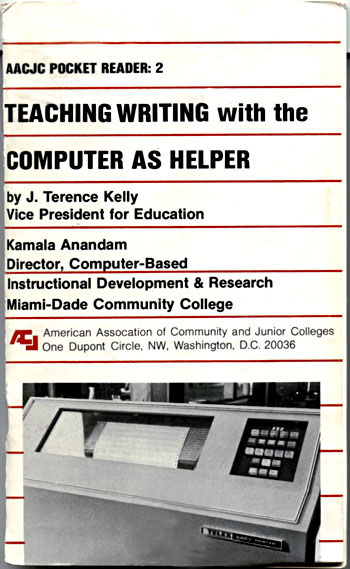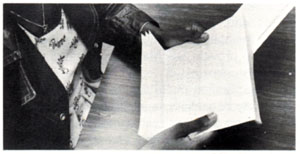CompPanels: Images from
the Annals of Composition #36
Computers and Individualization
|
 It
was an odd whim of college compositional history that staged two rival
enthusiasms during the same years (1970-1985): computing systems and
individualized instruction. To compositionists today the machinery of
automation and the pedagogy of “individual differences”
seem contradictory in some obvious ways, but back then the two appeared
to go individual hand in computerized glove. It
was an odd whim of college compositional history that staged two rival
enthusiasms during the same years (1970-1985): computing systems and
individualized instruction. To compositionists today the machinery of
automation and the pedagogy of “individual differences”
seem contradictory in some obvious ways, but back then the two appeared
to go individual hand in computerized glove.
The yearning for the match is readily seen in a book from that era,
small enough to fit easily in one’s hand. Teaching Writing
with the Computer as Helper was written by J. Terence Kelly and
Kamala Anandam and published as a 3.75" x 6.25" pamphlet in
1982 by the American Association of Community and Junior Colleges. The
book promotes a ten-year-old computer system at Miami-Dade Community
College that had been used, in part, for writing instruction. It was
a system that the authors insist "has the potential to individualize
instruction” (p. 16).Yet today we can detect contradictions in
the book's celebration of the marriage between computerization and individualization.
Our first clue is the cover to the book. If the computer is really an
instructional “helper,” why are there no humans in sight?
All we see is a Telex Model 5403 printer (it automatically typed input
from the mainframe). Photographs inside the book send the same message.
We see either computing equipment tended by computer specialists (here
is author Kelly with a bank of open-reel tape recorders) or students
tended by teachers in old-fashioned, pencil-in-hand, pre-computer
ways. Students and computers are separated.
Graphically, the closest students and computers approach one another
is in a photograph of a student holding some sheets of computer paper
that have been folded to fit inside a legal-size mailing envelop. The
student is reading the computer’s print- out
of a response to her last essay. The envelope was delivered to her by
her teacher. The teacher had created the response by reading the student’s
paper and then marking a bubblesheet of writing criteria, which the
computer had turned into the letter, with boilerplate amenities (“Thank
you for turning in Assignment 1”), boilerplate diagnosis (“Verb
Usage: Shift in Tense’), and boilerplate illustration of error
(“Verbs change in form to show the time of their action: Read
the following paragraph”). This computerized teacher's aide is
cleverly named RSVP: Response System with Variable Prescriptions. It
also kept records. Kelly and Anandam contrast photos of a messy handwritten
gradebook with the tidy RSVP bubblesheet, and hand-written teacher commentary
on a student essay with the printed computer letter. out
of a response to her last essay. The envelope was delivered to her by
her teacher. The teacher had created the response by reading the student’s
paper and then marking a bubblesheet of writing criteria, which the
computer had turned into the letter, with boilerplate amenities (“Thank
you for turning in Assignment 1”), boilerplate diagnosis (“Verb
Usage: Shift in Tense’), and boilerplate illustration of error
(“Verbs change in form to show the time of their action: Read
the following paragraph”). This computerized teacher's aide is
cleverly named RSVP: Response System with Variable Prescriptions. It
also kept records. Kelly and Anandam contrast photos of a messy handwritten
gradebook with the tidy RSVP bubblesheet, and hand-written teacher commentary
on a student essay with the printed computer letter.
Teachers could write individual messages on a student's paper if they
wished, but the computer system did not permit anything other than boilerplate
text in the letter to the student. Understand that RSVP used mainframe
technology of the 1970’s, before PCs and LANs were feasible for
university instruction—and, I can’t resist adding, apparently
before the American Association of Community and Junior Colleges acquired
computerized text-editing capability (although most publishers had it
by that time), at least inferring from the misspelling of their own
name on the cover to this book.
So how does RSVP promote individualized instruction? Kelly and Anandam
are quite open about this question, but their argument is a little mysterious.
The impersonality of the computer will “equalize” teacher
and student relations, and its speed will give teachers more time to
work one-on-one with students (p. 13). It seems the computer doesn’t
individualize instruction, teachers do. But its efficient delivery system
reduces “the drudgery and repetitiveness, which English teachers
have had to deal with in scoring students’ essays” (p. 6).
It is an argument that predates computers, of course. Ever since the
late 19th century the word “drudgery,” for instance, has
been a writing-teacher code term, used to sell a grab bag of labor-saving
devices, from criteria sheets, error symbols, lay readers, peer critique,
overhead transparencies, to actual rubber stamps. Now it is computer
house-elves willing to work for very long hours at very low wages.
Today “individualized instruction” does not have the éclat
it did in the 1960s and 1970s, and the defense of computers in writing
instruction has moved on to new machinery, new premises, and new rationales
(such as group identity). Another stage, another story.
RH, April 2006
Bibliographic note. Kelly and Anandam's pamphlet is
available on microfiche in the ERIC Document Reproduction Service, ED
214 583. An earlier version of their argument is "RSVP—an
Invitation to Individualize Instruction," Community and Junior
College Journal, March issue, 1978, pp. 24-26. For the compositional
history of the word “drudgery,” see Brian Huot, “Computers
and Assessment: Understanding Two Technologies,” Computers
and Composition 13.2 (1996), pp. 231-244; and my own “Automatons
and Automated Scoring: Drudges, Black Boxes, and Dei Ex Machina,”
in Patricia Ericsson and Rich Haswell (Eds.), Machine Scoring of
Students Essays: Truth and Consequences, Utah State University
Press (2006), pp. 57-78.
|